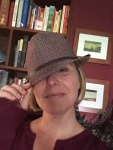
(This is Memorial Day when we all should be thinking about and thanking those who sacrificed their lives for us and our freedom in many wars. Photo is of hubby, a Vietnam Vet.)
Many authors are off on tours, visiting various book stores in their general area or some of the big names are heading around the country. I’ve never done that, nor will I in the future. Two reasons, I only visit some favorite book stores for signings, and I don’t travel as far as I once did.
My first book event this spring was giving a talk to the nearest chapter of Sister in Crime that I belong to about where I got the ideas for some of my books. It was great fun and well received.
(A tip about book talks–if you can make your audience laugh, you’ll sell books.)
Next was participating on a panel at a one day writing conference put on by the Central Coast chapter of Sisters in Crime—the panel topic, Finding Time to Write. I love going to the coast and seeing my friends over there, so it was a good time.
(Authors are usually readers too. )
I was asked to give a short talk about my books at a local women’s club. A small group but they were a great audience.
(Yes, I made them laugh, and they did buy books. )
Two events are scheduled for June. The first, I’m going to give a talk about the importance of editing to the Tulare-Kings writers group, and I am heading back to the coast to participate in the Cambria Book Fair. This will be my second book fair this year. I love them.
(With talks to writers, give them something they need to hear. Believe it or not, there are some self-pubbed authors out there who aren’t getting their books edited.)
In July, I’ll be Las Vegas for the Public Safety Writers Conference—which is my favorite. In some ways it’s like a big family reunion, except the family consists of mystery writers, people in all sorts of law enforcement, fire fighters, EMTs and other public safety professions.
I’ll be speaking to the Nightwriters in San Luis Obispo in August and I’m going to give the presentation about where I got my ideas for my books.
In October it’s the Great Valley Bookfest in Manteca and in November, a boutique in Yosemite in Coarsegold.
(Tip about any kind of book or craft fair. You can’t just sit behind your table and expect people to rush up an buy your books. You need to get on your feet, smile at folks, and engage them in conversation.)
That’s it so far, but I’m sure other events will trickle in.
Do I sell a lot of books at these events? It depends, and you never know. But I always love meeting people and talking about my books with them.
Fellow authors, what are you favorite type of events?
Readers, do you attend many of these kind of events, and if so which ones do you enjoy?
Marilyn











You must be logged in to post a comment.